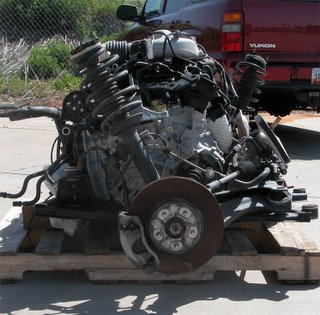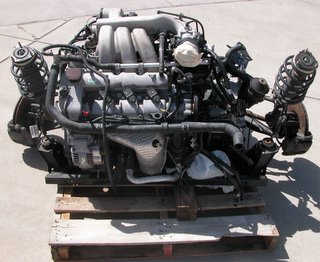Motor Project # 4 - More Disassembly


In the first picture, you can see the transfer case in place, still attached to the auto transaxle and I left the engine anti-roll mount in place, which I call the lower motor mount. The pictue on the upper center shows the front of the motor with all of the accessory hardware removed. Just the crankshaft pulley left to come off. The picture on the right shows the auto transaxle pan.  The final picture shows the engine top as best I could reach it with the camera. I've removed the fuel injection plenum and the remaining coolant hardware which is all metal tubular.
The final picture shows the engine top as best I could reach it with the camera. I've removed the fuel injection plenum and the remaining coolant hardware which is all metal tubular.
Interestingly, when I drained the transmission I found the fluid to be a very dark purple colour. Not nearly what I expected to find from a trans with only 15K miles on it. I assume that Jag uses Dexron fluid which should be much more red in colour. Another interesting factor is the design of the transfer case. It make a direct internal connection with the auto trans through a jack shaft. The only thing separating the transfer case fluid and the auto transaxle fluid is an internal seal in the transfer case. Of course, if this seal is breached, then fluids would interchange. In R/R procedures Jag uses a special tool to keep the jack shaft from coming completely out of the transfer case. The reason for that is the jack shaft uses a soft metal spring clip at the end of the spline to secure it in place in the trans axle. When it is removed, the spring clip is pretty much destroyed and would destroy the seal if the shaft were pulled through it. One future project I will completely disassemble the transfer case. Since I probably won't use it again and I'm sure I can't get parts for it, I'm curoius what it looks like inside.
BTW - I know that Jag states these cases are sealed for life and never need changing. I'm not of that school. Another point often missed is that JTIS GIVES a recommendation for an auto fluid change every 30K miles for extreme use conditions. To me, that means change the auto trans fluid every 30K miles.
And, now - just the engine on its stand. MY BRG 2.5L Sport anxiously awaits in the background as at least one possible outcome of these projects is that she is the recipient of this 3.0L motor in whatever form it finally takes. Enjoy the pictures!










 Here is the back bank. The one that lives in the dark and few ever get to see.
Here is the back bank. The one that lives in the dark and few ever get to see.







 exploring. More to come.
exploring. More to come.
